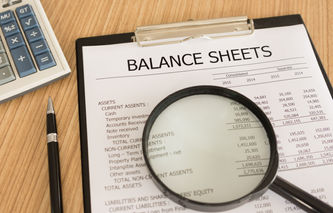This is the last, and final, article in our series describing cash flow concepts. In the paragraphs below, we’re going to explain how to go about building a cash flow statement. While many investors will never need to create this financial report, understanding the concepts provides a greater appreciation for its value when evaluating the financial health of a company.
Advantages of the Cash Flow Approach
The reason creditors and stock analysts are so interested in cash flow is because it's arguably the single most important indicator of a company's financial wellbeing. Unlike the income statement, cash flow is not influenced by accounting concepts like deferred income taxes or amortization of intangible assets.
It's often difficult to figure out exactly how well a company is performing when examining accruals and accounting adjustments. For this very reason, evaluating a company on a cash basis has a great deal of appeal to the financial community.
Simple Cash Flow Formula
When building a cash flow statement, it's important to keep the following in mind:
There is a starting balance of cash at the beginning of each accounting period.
There may be increases to cash via operations; the company made money on the products or services they sell.
Companies use cash throughout the year to pay for things: new assets and expenses.
Some companies may choose to raise additional cash throughout the year.
Using the above four pieces of information, it's possible to calculate a fifth value: the cash the company has at the end of the accounting period (or year). These building blocks of a cash flow statement are typically labeled as follows:
Cash and Cash Equivalents (Beginning) + Cash from Operations - Cash Flows from Investing Activities + Cash Flows from Financing Activities = Cash and Cash Equivalents (Ending)
In order to build a cash flow statement, we only need to be concerned with the above five elements.
Cash Flow Statements
The information from this point forward is really a tutorial explaining how to build a cash flow statement, also known as a statement of changes in financial position. As we walk through each step in the process, we'll provide insights and examples. At the end of this tutorial, we're going to provide a link to everything we've discussed in an example statement.
Cash and Cash Equivalents (Beginning)
The first step in this process is to figure out where a company left off in the prior accounting year. This will be the beginning balance for the current year. This value can be found on the company's prior statement of cash flow, the company's balance sheet, or it's possible to calculate the beginning value for cash.
Cash and cash equivalents are a current asset of a company, and this value can be found by looking at the company's balance sheet. This value can be calculated by adding cash, money market funds, certificates of deposit, savings accounts, and similar types of deposits.
In general, this is a current asset that can be readily exchanged for goods and services on short notice. In this example, we're going to start the company with $6,000,000 at the beginning of the year.
Cash from Operations
Next, we're going to look for cash generated by the operations of the company. This is sometimes referred to as cash provided by operating activities. To calculate the cash provided by operations, we need a starting point, which is net income.
One of the advantages of evaluating a company on a cash basis is that it's not subject to accounting methods that prevent analysts from getting a clear picture of a company's financial health. Unfortunately, net income does include some of those accounting adjustments. To truly understand the cash generated from operations, it's necessary to remove from the net income value what are called "non-cash transactions."
Items not Affecting Cash
While the most common example of a non-cash transaction is depreciation; there are two classes of adjustments to net income required to calculate cash from operations:
Depreciation / Amortization of Assets
Net Changes in Current Assets and Liabilities
If a company claimed depreciation expense in their income statement, that value needs to be added back. Likewise, if a company had an increase in accounts receivable, that value needs to be subtracted from net income. We're trying to figure out how much cash exchanged hands throughout the year. A company might have sold more goods and had a rise in accounts receivable, but until that money is received it's not considered cash.
Cash from Operations Example
Let's see how the above concepts would be used in practice. In this example, the company had net income of $8,000,000. The depreciation expense was $4,000,000, while accounts receivables went up by $2,000,000 and accounts payable went up by $1,000,000.
Net Income | $8,000,000 |
Depreciation Expense | $4,000,000 |
Net Change to Accounts Receivables | ($2,000,000) |
Net Change to Accounts Payable | $1,000,000 |
Total Adjustments to Operating Income | $3,000,000 |
Net Cash Flow Provided by Operating Activities | $11,000,000 |
In the above example, the non-cash expense depreciation would be added back to net income since money never really left the company's cash accounts. While a rise in accounts receivables (money not yet received) needs to be subtracted from net income (the company is still owed this money from customers).
Cash Flows from Investing Activities
The next step in building a cash flow statement is to look at money the company spent on new capital investments. If a company capitalizes an investment, that outflow of money does not show up on the income statement. That's because accounting rules allow the company to depreciate (expense) the cost of the investment over time.
From a practical standpoint, if a company purchases an asset such as new plant equipment or machinery, then they very likely paid for the asset with cash. When money leaves a company, there is an outflow of cash that needs to appear on the statement.
Cash Flows from Investing Activities Example
In this example, let's say the company purchased a new computer system for $1,500,000, along with an assembly line machine for $2,000,000. These were the only two capital investments made by the company in the year being examined. In this example, the company was also required to set aside $500,000 into a special decommissioning fund.
Normally, a company might show one line item for the capital investments and label that line item as Additions to Plant. In this example we're going to show these purchases as separate line items.
Cash Flows from Investing Activities | |
Purchase of New Computer | ($1,500,000) |
Purchase of Assembly Line Machine | ($2,000,000) |
Decommissioning Fund Contributions | ($500,000) |
Net Cash Used in Investing Activities | ($4,000,000) |
This section of the cash flow statement shows money that left the company to pay for assets. This information doesn't show up on the income statement because they are considered "investments." These investments will be depleted over their useful lives either through depreciation or other accounting adjustments. As this occurs, these investments appear as expenses on the income statement.
Cash Flows from Financing Activities
The final category of adjustments to be addressed on a statement of cash flows is money raised by financing activities. As was the case with cash from operations, it's possible to have both positive and negative adjustments to cash flow depending on the financing activities the company engaged in during the year.
Typical adjustments appearing in this section include changes in long and short term debt (issuing and redemption), issuing of preferred stock, issuing of common stock, retirement of stock, and stock dividends paid in cash.
Cash Flows from Financing Activities Example
In our example, the company decided to raise $250,000 by issuing common stock. They also issued $500,000 in short term debt, and redeemed $3,000,000 in long term debt. Finally, they paid a cash dividend on common stock of $2,000,000.
Net Cash Flows from Financing Activities | |
Increase in Short Term Debt | $500,000 |
Redemption of Long Term Debt | ($3,000,000) |
Issuance of Common Stock | $250,000 |
Cash Dividends on Common Stock | ($2,000,000) |
Net Cash Provided by (Used in) Financing Activities | ($4,250,000) |
As the above table demonstrates, the company used more money in their financing activities than they generated during the year.
Cash and Cash Equivalents (Ending)
Our final task involves calculating the ending cash balance for the company. This involves adding all of the prior adjustments to determine if there was a net increase or decrease to cash. This value (either positive or negative) is then added to the starting balance to derive the ending balance.
Ending Cash Equivalents Example
Cash and Cash Equivalents at the Beginning of the Period | $6,000,000 |
Net Increase / Decrease in Cash and Cash Equivalents | $2,750,000 |
Cash and Cash Equivalents at the End of the Period | $8,750,000 |
We began this example by stating the company started with a $6,000,000 balance of cash. Adding all of the adjustments, there was a net increase of $2,750,000. Therefore, the company's ending balance stands at $8,750,000.
Cash Flow Statement Worksheet
As promised, we're going to finish this topic by providing a link to a cash flow statement spreadsheet. In this worksheet, all of the example information used throughout this tutorial can be found, including all of the necessary calculations.
This article finishes a three-part series on cash flow, which also included building business cases using a cash flow approach as well as interpreting the result of a cash flow business case.




